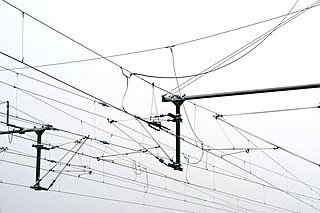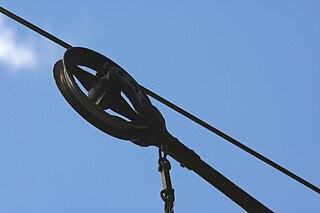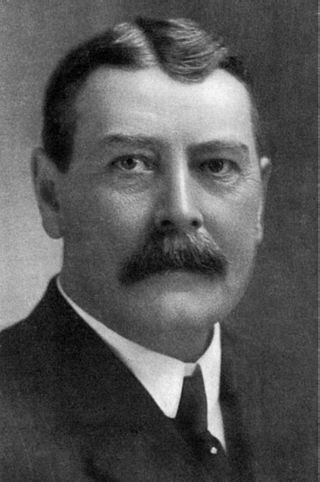
An overhead line or overhead wire is an electrical cable that is used to transmit electrical energy to electric locomotives, trolleybuses or trams. The generic term used by the International Union of Railways for the technology is overhead line. It is known variously as overhead catenary, overhead contact line (OCL), overhead contact system (OCS), overhead equipment (OHE), overhead line equipment, overhead lines (OHL), overhead wiring (OHW), traction wire, and trolley wire.

A crane is a type of machine, generally equipped with a hoist rope, wire ropes or chains, and sheaves, that can be used both to lift and lower materials and to move them horizontally. It is mainly used for lifting heavy objects and transporting them to other places. The device uses one or more simple machines to create mechanical advantage and thus move loads beyond the normal capability of a human. Cranes are commonly employed in transportation for the loading and unloading of freight, in construction for the movement of materials, and in manufacturing for the assembling of heavy equipment.

Intermodal freight transport involves the transportation of freight in an intermodal container or vehicle, using multiple modes of transportation, without any handling of the freight itself when changing modes. The method reduces cargo handling, and so improves security, reduces damage and loss, and allows freight to be transported faster. Reduced costs over road trucking is the key benefit for inter-continental use. This may be offset by reduced timings for road transport over shorter distances.

A warehouse is a building for storing goods. Warehouses are used by manufacturers, importers, exporters, wholesalers, transport businesses, customs, etc. They are usually large plain buildings in industrial parks on the outskirts of cities, towns, or villages.

A transmission tower is a tall structure, usually a lattice tower made of steel that is used to support an overhead power line. In electrical grids, transmission towers carry high-voltage transmission lines that transport bulk electric power from generating stations to electrical substations, from which electricity is delivered to end consumers; moreover, utility poles are used to support lower-voltage sub-transmission and distribution lines that transport electricity from substations to electricity customers.

A truss bridge is a bridge whose load-bearing superstructure is composed of a truss, a structure of connected elements, usually forming triangular units. The connected elements, typically straight, may be stressed from tension, compression, or sometimes both in response to dynamic loads. There are several types of truss bridges, including some with simple designs that were among the first bridges designed in the 19th and early 20th centuries. A truss bridge is economical to construct primarily because it uses materials efficiently.

An overhead power line is a structure used in electric power transmission and distribution to transmit electrical energy along large distances. It consists of one or more conductors suspended by towers or poles. Since most of the insulation is provided by air, overhead power lines are generally the lowest-cost method of power transmission for large quantities of electric energy.
Mahatma Gandhi Setu is a bridge over the river Ganges in Bihar, India, connecting Patna in the south to Hajipur in the north. Its length is 5,750 metres (18,860 ft) and it is the third-longest river bridge in India. It was inaugurated in May 1982 in a ceremony in Hajipur by the then prime minister, Indira Gandhi. From 1982 to 2017, Mahatma Gandhi Setu remained as the longest bridge in India. Later, Gandhi Setu rehabilitation project was undertaken to install triangular steel trusses on Mahatma Gandhi Setu.

An overhead crane, commonly called a bridge crane, is a type of crane found in industrial environments. An overhead crane consists of two parallel rails seated on longitudinal I-beams attached to opposite steel columns by means of brackets. The traveling bridge spans the gap. A hoist, the lifting component of a crane, travels along the bridge. If the bridge is rigidly supported on two or more legs running on two fixed rails at ground level, the crane is called a gantry crane or a goliath crane.

A hoist is a device used for lifting or lowering a load by means of a drum or lift-wheel around which rope or chain wraps. It may be manually operated, electrically or pneumatically driven and may use chain, fiber or wire rope as its lifting medium. The most familiar form is an elevator, the car of which is raised and lowered by a hoist mechanism. Most hoists couple to their loads using a lifting hook. Today, there are a few governing bodies for the North American overhead hoist industry which include the Hoist Manufactures Institute, ASME, and the Occupational Safety and Health Administration. HMI is a product counsel of the Material Handling Industry of America consisting of hoist manufacturers promoting safe use of their products.
The Crane Manufacturers Association of America, Inc. (CMAA) is an independent trade association in the United States. It is affiliated with the United States Division of Material Handling Industry. The voluntary association was incorporated as the CMAA in 1955.

Material handling equipment (MHE) is mechanical equipment used for the movement, storage, control, and protection of materials, goods and products throughout the process of manufacturing, distribution, consumption, and disposal. The different types of equipment can be classified into four major categories: transport equipment, positioning equipment, unit load formation equipment, and storage equipment.

Sir William Arrol & Co. was a Scottish civil engineering and construction business founded by William Arrol and based in Glasgow. It built some of the most famous bridges in the United Kingdom including the second Tay Bridge, the Forth Bridge and Tower Bridge in London.

A current collector is a device used in trolleybuses, trams, electric locomotives and EMUs to carry electric power (current) from overhead lines, electric third rails, or ground-level power supplies to the electrical equipment of the vehicles. Those for overhead wires are roof-mounted devices, those for rails are mounted on the bogies.

An ironworker is a tradesman who works in the iron-working industry. Ironworkers assemble the structural framework in accordance with engineered drawings and install the metal support pieces for new buildings. They also repair and renovate old structures using reinforced concrete and steel. Ironworkers may work on factories, steel mills, and utility plants.

Joy Global Inc. was a company that manufactured and serviced heavy equipment used in the extraction and haulage of coal and minerals in both underground and surface mining. The company had manufacturing facilities in Alabama, Pennsylvania, Texas, Wisconsin, Australia, Canada, China, France, South Africa, Poland and the United Kingdom. In 2017, Joy Global was acquired by Komatsu Limited and was renamed Komatsu Mining Corp.
Mukand Limited is an India-based manufacturer of stainless steel, alloy steel, and stainless steel billets, and is an exporter of hot rolled bars. The company manufactures iron and steel products, steel castings, steel structurals, Electrical Overhead Travelling (EOT) and other cranes, and other industrial machinery. Mukand Ltd is part of the Bajaj Groups of companies. It makes India's largest gantry crane, with an 80-tonne capacity and 60-metre span, with monobox girder and underslung trolley.

Vidyasagar Setu, also known as the Second Hooghly Bridge, is a toll bridge over the Hooghly River in West Bengal, India, linking the cities of Kolkata and Howrah.
Joseph Booth & Bros was an English company notable for making cranes used in large construction projects.

The Arrol Gantry was a large steel structure built by Sir William Arrol & Co. at the Harland and Wolff shipyard in Belfast, Northern Ireland. It was built to act as overhead cranes for the building of the three Olympic-class liners.

















